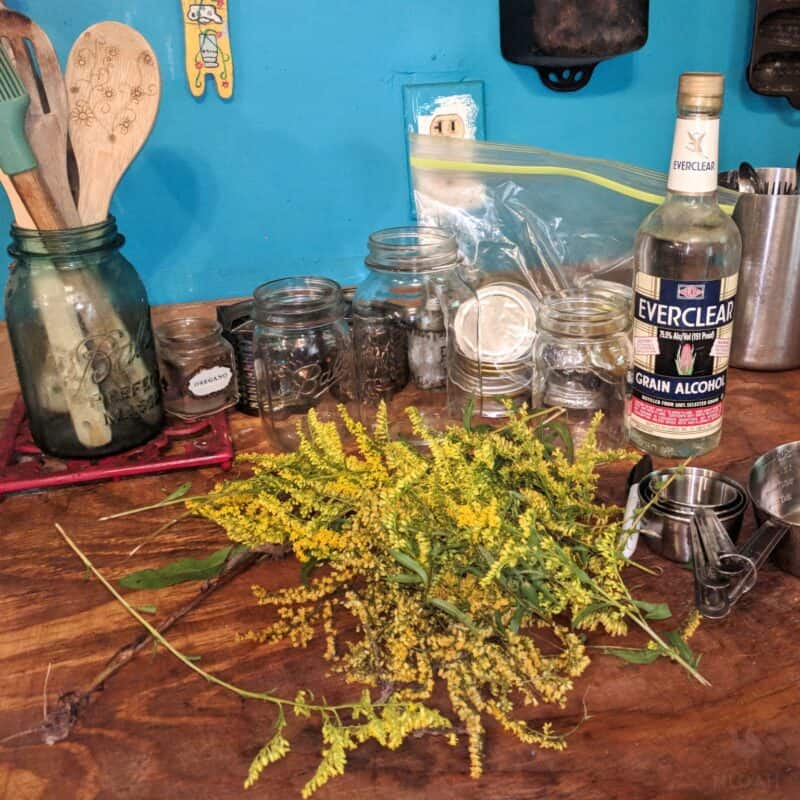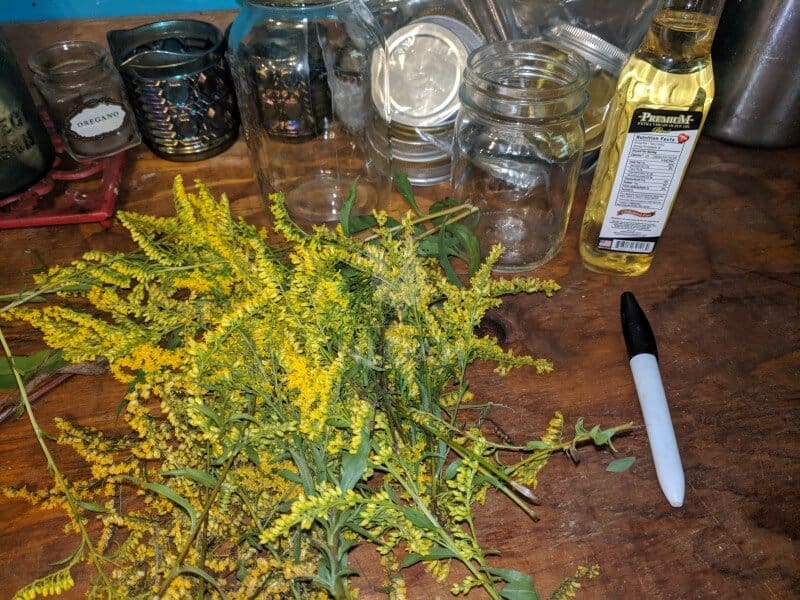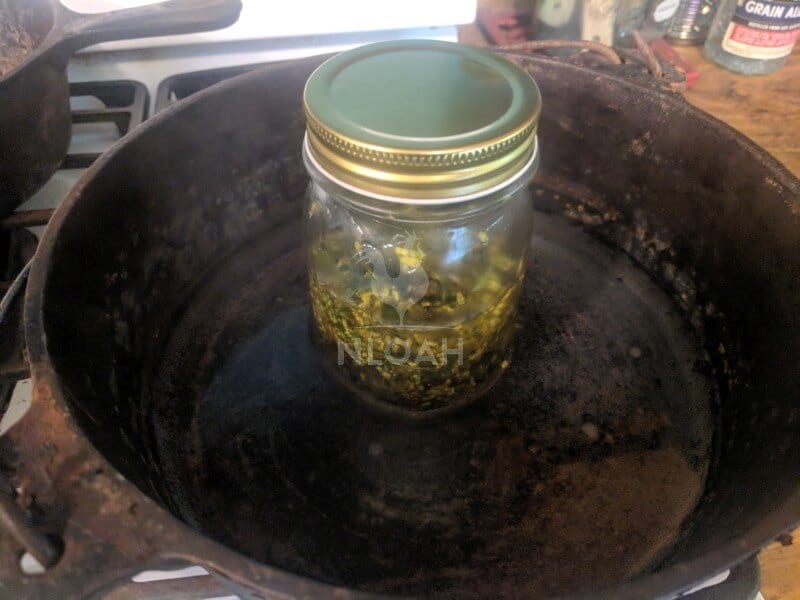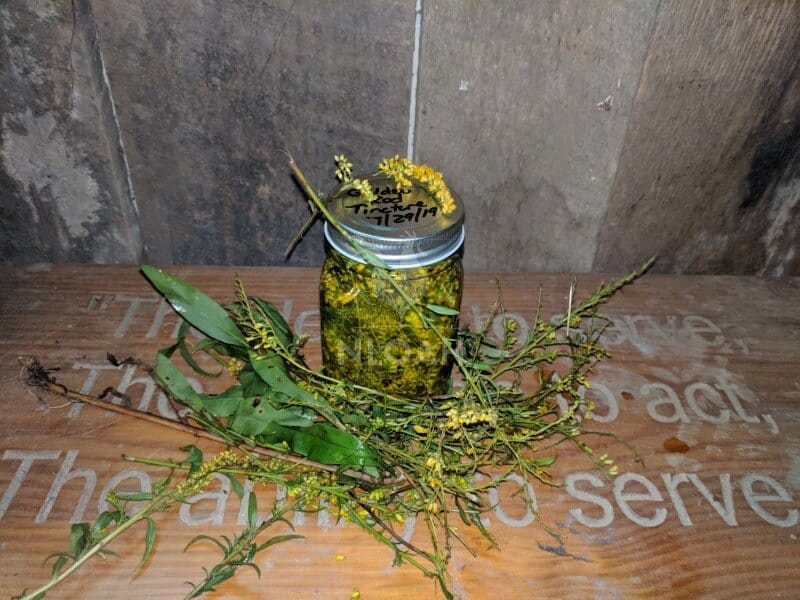Goldenrod is both a beautiful, and often hated wild weed. For folks suffering from haya fever and related seasonal allergies, this late July or August bloomer is dreaded.
But, contrary to popular belief, it is often just the plain Jane ragweed that grows with goldenrod, that causes all of the annoying, and somewhat painful allergy symptoms.

Now, I am not saying you will not have an allergic reaction to goldenrod, some people truly do. I just want to note that sneezing, itching, stuffy noses, and watery eyes are not necessarily going to happen if you forage goldenrod for wildcrafting purposes.
All of the above ground portions of the goldenrod plant are edible. You can make some tasty recipes and salad dressings using foraged goldenrod flowers. But the primary reason foragers seek out goldenrod is for its possible natural healing properties. This plant is pretty easy to identify, perfect for novice foragers.
This yellow so-called weed has been used to treat:
- Gout
- Kidney Stones
- Arthritis
- Sinus Infection
- Tuberculosis
- Vaginal Yeast Infections
- Hemorrhoids
- … and more
Goldenrod tinctures and infusions have also been used in natural healing recipes crafted to treat cold and flu symptoms, the healing of minor wounds, as both an internal and external anti-inflammatory aid, and to curb high blood pressure.
The saponins, quercetin, and flavonoid antioxidant naturally occurring compounds in goldenrod have long been touted as the primary reasons the wild plant can be beneficial in healing wounds and combating illness.
The FDA has not approved goldenrod to be used as a drug nor has the federal agencies validated any claims about its healing power. I am not a medical professional of any type.
The information in this article is shared purely for educational or research purposes. You should always contact your doctor or medical care giver before embarking on any type of natural medicine or healing regimen.
You can also forage for goldenrod to make a fragrant, soothing, and possibly healing, soup.

How To Make Goldenrod Infused Oil
1. Place 1 cup of goldenrod flowers in a Mason jar – preferably dried, but fresh non-damp flowers will work as well.
2. Pour about 12 ounces of olive oil into the glass jar. It is essential that all of the flowers are completely covered in the olive oil so they become thoroughly saturated during the infusion process.
Next, you must process the goldenrod infusion. You can use the tried and true albeit slow processing method or opt instead for a short cut that reduces the processing time by more than half.
Traditional Processing Method
- Seal the Mason jar – or whatever glass jar you chose to use, with a firm-fitting lid.
- Set the jar in a spot that is both cool and dark – but not cold, for a minimum of four weeks. Allowing the goldenrod infusion to process for six weeks is highly recommended and will make the mixture more potent.
- Shake the jar of foraged goldenrod once a day.
- Before uncapping the infusion to strain, shake it vigorously for about 1 minute.
- Pour the contents through a fine strainer, catching the liquid, and pitching the goldenrod flowers.
For best results, store the goldenrod infusion in small glass containers – amber glass jars if possible, to avoid overly exposing the contents to air, moisture, and debris. Store in a cool dark place for best results when not using amber glass jars. Even if you are using amber glass bottles, keep the goldenrod infusion out of direct sunlight.

The Quick Method
- Place the glass jar containing the goldenrod infusion mixture into a double boiler or a sauce pan with several inches of water in the bottom.
- Turn the stove burner on low – you only want the water to heat to a consistent simmer.
- Simmer the goldenrod infusion mixture for at least two but preferably three, hours.
- Place the goldenrod infusion out of direct sunlight and allow it to settle for two to three days. Some folks use the infusion immediately as soon as it cools enough to touch. This is fine, but the infusion will not likely be as potent as it would have been if it had been allowed to settle for approximately 72 hours.
- Pour the goldenrod infusion through a fine strainer – catching the liquid, and then pitching the natural matter.
- Store as noted above.
When processed and stored properly, goldenrod infusion should be shelf stable for about two years.
Goldenrod Tincture
- Place enough dried or fresh goldenrod flowers into a Mason jar to fill it at least halfway up. Ideally, you should forage enough goldenrod to fill the chosen glass jar three quarters of the way full. Using small bits of leaves or stem in the tincture is alright.
- Pour in two parts of either Everclear or vodka to 1 part water. Fill the glass jar up to the lip just as you would do when canning.
- Put the canning lid and ring, reusable canning lid, or other firm-fitting lid onto the jar and make certain it fits securely.
- Shake the goldenrod tincture mixture vigorously for a minimum of 30 seconds.
- Write the name of the mixture and the date it was made on the lid or on a piece of tape attached to the jar itself.
- Store the jar in a dry and cool place for 30 days, shaking it once every day.
- Shake the goldenrod tincture mixture briskly for close to a minute before removing the cap and pouring through a fine strainer to capture the liquid. Pitch the natural matter in the strainer.
- Store in small containers with a firm-fitting lid to avoid exposing the tincture too frequently to air, moisture, and potential debris.

When processed and stored properly, goldenrod tincture can remain shelf stable for at least two years. Adults with gout or kidney stones often take up to four droppers of the tincture daily for up to two weeks until the symptoms of their condition subside.
Again, always consult your physician before embarking on a natural remedy routine. If you are allergic to members of the aster flower family, you may be allergic to goldenrod.
Goldenrod Salve
Yield: 6 fluid ounces
Ingredients
- 5 ounces of beeswax
- 3 ½ ounces of goldenrod infusion
Directions
- Pour about 2 inches of lukewarm water in a medium sauce.
- Place a 1 pint Mason jar or similar glass heat-proof jar of another kind into the pan.
- Pour the goldenrod infusion into the glass container carefully, do not spill your ingredients into the water.
- Next, pour in the beeswax. I recommend using beeswax pastilles because they are small and will not take as long to melt as chunks of beeswax. Stir frequently no matter what type of beeswax you use to avoid scorching.
- Simmer the mixture over only low to medium heat until the beeswax has thoroughly melted and combined with the goldenrod infusion. Do not let the mixture come to a boil and continue to stir constantly to avoid scorching.
- As soon as all of the ingredients are combined and melted, pour the goldenrod salve into a tub or individual containers with a firm fitting lid.
- In my experience, goldenrod salve stored in about 2 ounce containers that are stored in a cool dry place (including my purse and bugout bag) remain viable for a minimum of two years. If mixture starts to melt in the heat, just get it out of the direct sunlight and it will harden up again.
Always make sure you can clearly identify any wild edible or medicinal plant, weed, fruit, nut, or berry you are foraging before harvesting or using it. Never forage wildcrafting material from any location that you are not 100% sure has not been sprayed with chemical pesticides or herbicides.

Tara lives on a 56 acres farm in the Appalachian Mountains, where she faces homesteading and farming challenges every single day, raising chickens, goats, horses, and tons of vegetables. She’s an expert in all sorts of homesteading skills such as hide tanning, doll making, tree tapping, and many more.

I made mine with coconut oil with my goldenrod. That makes it very creamy and smooth. A lot of people confuse goldenrod and golden seal. Goldenseal and ragweed are in the same family but golden seal is in a completely different. Goldenrod is actually great for allergies.
My GR salve is brick hard, though I followed the recipe so carefully. Is the 5 ounces of beeswax correct?
When I make salves, I use about 4 tablespoons grated beeswax for 2 cups of the infusion I’m using.
You can reheat the salve and put more of the herb oil into it. Dip a spoon into the pan and let sit until firm. When you’re satisfied with the firmness, pour rest into tins or jars for use.
Hello! Do you wash the goldenrod first if making a tincture? Thanks!
I love this site! Your information and recipes are invaluable.
Thank you Cheryl, glad you are finding useful information!
Do you have a good close up photo of the goldenrod?
Sue, I will see about uploading one.